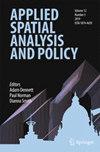Examining Cross-city Travel Behaviour and its Associated Spatial Structure Using Dockless Bike-sharing Data
Abstract
Bike-sharing provides a convenient means of transport for short-trip travellers and is considered an efficient way to solve the first-and-last-mile problem. However, existing studies have paid little attention to cross-city travel in the bike-sharing context, or to its potential to reveal the spatial structure of cities. This paper considers two types of cross-city travel behaviour: the first involves a traveller taking a single trip from one city to another (Type I); and the second refers to a traveller making two consecutive trips in two cities, suggesting that a cross-city trip between these two cities has occurred (Type II). Using dockless bike-sharing big data from Zhejiang Province (China), we adopt a network-based approach to examining cross-city travel behaviour and its associated spatial structure. Our results show that it is less common for cyclists to undertake cross-city travel than to only travel within a single city, and that it is more difficult to travel across prefecture-level cities in comparison to county-level cities. Spatial structure varies greatly between different city levels and for different types of cross-city journeys. The county-level cross-city patterns identified 10 spatial communities, some of which show inconsistencies between their community-based and administrative boundaries. This study could help to advance our understanding of the characteristics of cross-city travel behaviour and its associated spatial structure. It also provides some useful implications for policy-making and practical operations.

 求助内容:
求助内容: 应助结果提醒方式:
应助结果提醒方式:


